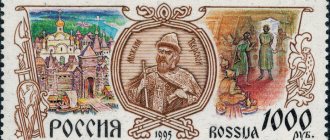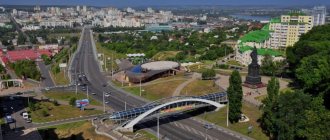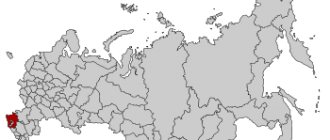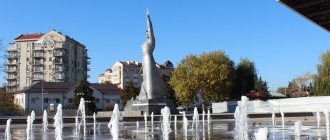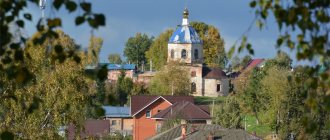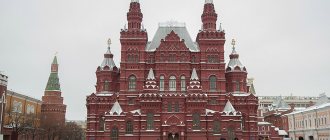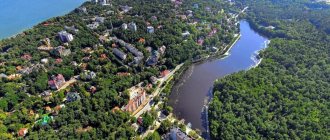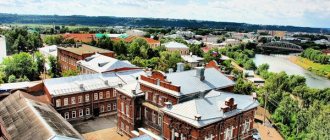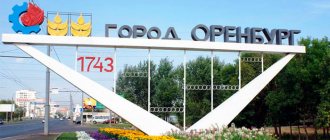| Kashin city |
Kashin
, a city in Russia, the administrative center of the Kashinsky district of the Tver region, the second cathedral city of the Tver diocese. Located on the banks of the Kashinka River (the left tributary of the Volga River), in the southeast of the region, 150 km from Tver, 180 km from Moscow. Railway station on the Savyolovo-Sonkovo branch. Population - 15.8 thousand (2012).
- On the map: Yandex.Map, Google map
One of the oldest cities in the Tver land, the only resort city in the Tver region.
Kashin is called the “city of the Russian heart” due to the fact that the Kashinka River, meandering through the city, forms the exact silhouette of a heart. In the century, the Kashinsky region was part of the Novgorod land. At this time, there was a stubborn struggle between Rostov the Great and Veliky Novgorod for the mastery of the Upper Volga. By the end of the century, the border between the Rostov-Suzdal land and the possessions of Novgorod already passed along the mouth of the Medveditsa River. Thus, the territory of present-day Kashin was part of the Rostov principality, then Pereyaslavl. Around 1247, the independent Principality of Tver was formed, and the Kashin lands became part of it.
The exact date of the city's founding is unknown. The first mention of the city dates back to 1238: in the Nikon Chronicle, Kashin is mentioned among the cities devastated by the Mongols. Based on more reliable sources, the founding of the city is usually attributed to 1288, when Grand Duke Dmitry Alexandrovich and his allies went on a campaign against Mikhail Yaroslavich Tverskoy. The city was under siege for 9 days, but was not taken.
In 1319, Vasily, the son of Mikhail Tverskoy, received Kashin as an inheritance, this marked the beginning of the independent Kashin principality. Under him, the Assumption Monastery was founded in the Kremlin for his mother, later canonized Anna Kashinskaya.
In 1382, Kashin again became part of the Tver Principality.
In 1400-1425, Kashin was the capital of an independent principality.
Despite the dependence on Tver, the city minted its own coin (pul) and carried out chronicle work. The city gradually turned into a large trading center; Kashin merchants traded with near and far lands. Crafts developed, especially the production of white paints.
In 1485, Kashin, like the entire Tver Principality, went to Moscow, which caused the temporary decline of Kashin as a commercial and industrial center.
In 1504-1533, Kashin became part of the Dmitrov appanage principality under the rule of Yuri Ivanovich.
During the Time of Troubles, the city was destroyed by the Poles, in 1654 a plague epidemic hit the city, and in 1676 Kashin burned almost to the ground. However, the city quickly regained its potential. Along with the production of the best paints in Russia, the city was famous for its blacksmiths, potters and icon painters, as well as its fairs. The development of the city was greatly facilitated by the founding of St. Petersburg, the commissioning of the Vyshnevolotsk water system and the general development of the northern lands under Peter I. The Kashin merchants extended their influence to the new capital. Many of them received contracts to provide Peter's army with weapons and provisions. The growing prosperity of merchants and artisans was also reflected in the appearance of the city. By the end of the 18th century, the city already had many stone houses and churches.
The administrative position of Kashin changed several times during the 18th century. In 1708 it was assigned to the Ingermanland province, from 1719 it was part of the Uglich province of St. Petersburg, and from 1732 to the Moscow province. During the provincial reform of 1775, the Tver governorate was formed. Kashin was included in its composition as a county town. At the same time, part of the ancient Kashin lands went to the newly formed Kalyazinsky district. In 1777, the regular general plan of Kashin was approved, and in 1780, the city coat of arms depicting three stacks of whitewash was approved.
During the Patriotic War of 1812, merchants fully provided the city's militia with weapons and food. At the same time, flax growing began to develop rapidly in Kashin and the surrounding area, bringing new profits to the city.
In 1884, a resort was opened on local mineral waters.
In 1898, a railway was opened connecting Kashin with the capital, St. Petersburg. At the same time, stone shopping arcades were built.
During Soviet times, Kashin developed as the center of an agricultural, mainly flax-growing region. In 1927, the district was liquidated by joining the Kimry district. In 1929, the Kashinsky district was formed within the boundaries of the former district, which became part of the Moscow region, and in 1935 - the Kalinin (now Tver) region.
Religion
Kashin is a large church center; since the 16th century, the Tver archbishops have been called Tver and Kashinsky. At the beginning of the 16th century, the first stone cathedral was erected in the city - the Resurrection Cathedral.
By the beginning of the century, there were 33 churches (3 of which were cemeteries) and 12 monasteries in Kashin. The Kashin Theological Seminary and the Kashin Theological School operated in the city.
In 1919 - 1920 there was a Kashin vicariate of the Tver diocese.
At the beginning of the 21st century, Kashin is the second cathedral city of the Tver diocese.
The Saints
- blgv. led book Anna Kashinskaya
- St. right Vasily Kashinsky
- St. Dorofea Kashinskaya
- St. Efrem Perekomsky
- St. Macarius Kalyazinsky
- St. Savva Vishersky
Monasteries
- Nikolaevsky Klobukov (female)
- Sretensky (inactive)
- Dimitrovsky (inactive)
- Uspensky (inactive)
Temples of the city
- Alexy Metropolitan of Moscow, monastery (see Kashinsky Klobukov Monastery)
- Anna Kashinskaya
- Ascension of the Lord, Cathedral
- Resurrection of the Lord, Cathedral
- Hermogenes of Moscow, house temple
- Elijah the Prophet (inactive)
- Signs of the Holy Cross
- Peter and Paul, courtyard of the Klobukov Monastery
- Protection of the Blessed Virgin Mary, monastery (see Kashinsky Klobukov Monastery)
- Nativity of Christ
- Trinity Life-Giving, monastery (see Kashinsky Klobukov Monastery)
Temples of the Deanery
- St. Nicholas the Wonderworker in the village of Leushino
- St. Nicholas the Wonderworker in the village of Savtsyno
- Chernigov Icon of the Mother of God in the village. Ursa
- Annunciation of the Blessed Virgin Mary in the village. Apraksino
- All-Merciful Savior in the village. Slavkovo
- The descent of the Holy Spirit on the apostles in the village of Upper Trinity
- Intercession of the Blessed Virgin Mary in the village. Semenovskoe
- Trinity Life-Giving in the village. Lobkovo
- Trinity Life-Giving in the village. Units
Kashin: resort city and capital of the ancient principality
We continue the series of publications dedicated to the cities of the Tver region.
Today Kashin is a small regional center with a population of about fifteen thousand people, and once it was the center of an independent Russian principality, which even competed with Tver. In the 19th century, a sanatorium was opened near the mineral water sources, and now Kashin is the only resort in our region. And during the short period of occupation of Kalinin, this town, in fact, served as the regional capital.
This is very short, but you and I, dear readers, are thoughtful and thorough people, and therefore we will start in order.
Ancient Russian city
Kashin is considered one of the oldest cities in our region. And although the exact date of its foundation is unknown, in the Nikon Chronicle it is mentioned as one of the cities devastated by the Tatar-Mongols. Thus, by 1238 Kashin was a fairly developed settlement by the standards of that time. In 1287, the city was again mentioned in the chronicle - unfortunately, again this refers to military operations. Then, for nine days, Kashin was besieged by the troops of Dmitry Alexandrovich, Prince of Vladimir, and his allies.
For some time, historians believed that Kashin in the 13th century was part of the Uglitsky principality. However, more detailed and scrupulous work with sources revealed: in fact, this city for some time belonged to the Pereyaslavl-Zalessky principality. The even more ancient city of Ksnyatyn, founded in 1135 by Yuri Dolgoruky, was also included in it. From the beginning of the 14th century, it was part of the independent Kashin principality, which we will talk about a little further, and in the middle of the 15th century, Ksnyatin (aka Konstantin) was mentioned in chronicles as a village. Today it is a small settlement called Sknyatino, and it belongs to the Kalyazinsky district.
But let's return to the story of Kashin. Just as the date of its foundation is hidden in the darkness of time, the origin of the name is also unknown for certain. A number of researchers believe that the names Kashin and Kashinka (the river on the banks of which the city stands) are of Finno-Ugric origin. This version can be considered quite reliable, given that earlier, even before the Slavs, Finno-Ugric tribes actually lived in these places. And the word “kashina” means a river overgrown with reeds. Kashinka itself fully corresponds to this name. And the city of Kashin, thus, took its name from her.
There is another version - simpler and, as they say, just begging to be spoken. We are sure that you yourself have already guessed what we are talking about. Well, of course, porridge is one of the most common Russian dishes. And the name of the city, they say, came from this dish. This assumption also has a right to exist; moreover, there is even corresponding written evidence. True, we hasten to emphasize: we are talking, in particular, about the recording of one of the landowner’s estates in the album. So, most likely, the version with porridge still refers to local legends. But the Finno-Ugric origin of the name, perhaps, should still be considered more logical. So we will accept the hypothesis of an overgrown river as a basis, but at the same time we will not impose it. Who likes what.
Kashin and his lands became part of the Tver Principality in 1247, but then its history again resembles one well-known American series based on the books of George Martin.
Principality of Kashin
How did it happen that Kashin moved away from Tver for some time? As usual, the harsh realities of that time were to blame. Let us recall that in 1318 Mikhail Yaroslavich Tverskoy died in the Horde, and soon the territory of the grand duchy was divided between the sons of the ruler. Tver itself and the surrounding lands went to the eldest, Dmitry Groznye Ochi, the southwest with the cities of Mikulin, Zubtsov, Kholm and Staritsa (then Gorodok) - to Alexander, the south with Klin - to Konstantin, and the northeast (Kashinsky inheritance) - to Vasily, the younger from the sons of Mikhail Yaroslavich.
The eldest sons occupied the Tver Grand Duke's table at different times. Alas, they all did not die a natural death. Dmitry and Alexander were executed, and Konstantin ended his life in the Horde - there is an assumption that he was poisoned. Thus, power eventually had to pass to Vasily. However, Khan Janibek decided in his own way and issued a label for the great reign to the Kholmsky prince Vsevolod Alexandrovich, the nephew of Vasily Mikhailovich. This happened in 1345.
Prince Vasily of Kashin, however, did not want to give in to his relative and finally managed to get the coveted label from Janibek. The nephew, of course, resisted, but ultimately gave in to his uncle - largely thanks to the Bishop of Tver Theodore, who managed to reconcile his relatives. So in 1349, the youngest son of Mikhail Yaroslavich became the next great prince of Tver.
The Kashinsky inheritance, which he inherited according to his father’s spiritual charter, was transferred first by Vasily to his eldest son (also Vasily), and after his death - to the younger Mikhail. However, let’s not forget: in order to become the head of the Tver principality, Vasily Mikhailovich came into conflict with his nephew, so relations between representatives of the two branches of Mikhail Yaroslavich’s heirs were, to put it mildly, strained. According to the peace agreement of 1360, the grand-ducal table remained with Vasily Mikhailovich. Vsevolod, whom Prince Vasily “pushed away” from supreme power on Tver land, secured a foothold in Kholm and Staritsa, Mikhail Alexandrovich retained Mikulin, and Vladimir and Andrey (Alexander’s younger sons) stayed in Zubtsov.
In the middle of the decade, the plague, a terrible disease of the Middle Ages that destroyed entire cities, came to the Tver Principality. In addition to ordinary people, rulers also did not escape the tragic fate - Princess Anastasia, the widow of Alexander Mikhailovich, died, and her three sons also died. The only survivor, Mikhail, received the inheritance of his brothers Vladimir and Andrey, who left no heirs. And in 1365, he captured the Tver Grand Duke's table, as a result of which his uncle Vasily Mikhailovich fled to Kashin. At the same time, Mikhail Alexandrovich received by will half of the Klin inheritance, which belonged to Semyon Konstantinovich, who also died of the plague.
However, in the end, due to a local, seemingly princely, feud, a real war broke out with the participation of Moscow and even Lithuania.
Lithuanian-Moscow War
On the side of Vasily Mikhailovich, who settled in Kashin, the Grand Duchy of Moscow came out. In many ways, family ties were involved here - the fact is that the son of the Kashin prince Mikhail was married to Princess Vasilisa, the daughter of Simeon the Proud and the granddaughter of Ivan Kalita. On the other hand, a similar situation took place - the husband of Mikhail Alexandrovich’s sister, Juliana, was the Lithuanian prince Olgerd.
Vasily Kashinsky with his son Mikhail, Prince Eremey Dorogobuzhsky, as well as with Muscovite regiments, moved to Tver and organized a siege. It was not possible to capture the capital of the Grand Duchy, but the settlements on the right bank of the Volga were subjected to numerous robberies. Mikhail Alexandrovich at that time was in Lithuania, with Prince Olgerd, and could not repel the enemy. However, he soon returned with help in the form of Litvinian regiments and, having defeated Eremey’s troops, moved to Kashin. However, Bishop Vasily of Tver dissuaded him from storming the city, and Michael’s warriors turned back.
In 1368, Dmitry Donskoy invited the Tver prince to Moscow. There, despite security guarantees from Metropolitan Alexei, Mikhail Alexandrovich was captured and imprisoned. Perhaps the Tverite was awaiting execution, but he was saved by the unexpected arrival of three murzas (representatives of the Tatar nobility) from the Horde in the capital of the Moscow principality. Mikhail was released, but returned not to Tver, but to Lithuania, to his son-in-law Olgerd.
In the autumn of the same year, the Lithuanians moved towards Moscow. Thanks to military cunning (they attacked not from the north-west, where they were expected, but from the south-west), they gained a strong advantage, and Dmitry Donskoy managed to send only a guard regiment to meet them. Olgerd's troops, meanwhile, defeated the squad of Semyon Nettle, Prince of Starodubsky. Next, the Lithuanians captured the city of Obolensk and killed the local prince Constantine, and on November 21, in the Battle of the Trosna River, the Lithuanian prince’s troops defeated the Moscow guard regiment. Dmitry Donskoy himself took refuge in Moscow, where Olgerd had already approached, but the three-day siege did not bring victory to the Lithuanians. Having plundered the surrounding area, taking away cattle and many prisoners, Olgerd left. Perhaps he would have been able to take the Kremlin, but news came from the west: Livonian knights had invaded Lithuania. That is why Olgerd and his regiments urgently moved to their homeland.
But the Lithuanian-Moscow war did not end there. In 1370, the troops of Prince Olgerd and his brother Keistut suffered a crushing defeat from the Teutons at the Battle of Rudau, and Dmitry Donskoy again besieged Tver. Of course, the response move was not long in coming. Mikhail Alexandrovich Tverskoy, Svyatoslav Smolensky, as well as Olgerd and his brother Keistut moved towards Moscow. On the way, the troops attacked Volokolamsk, killed Prince Vasily Berezuisky and plundered the surrounding area for three days. The siege of the capital began in December of the same year, at the same time Vladimir the Brave, cousin of the Moscow prince, was gathering troops in Przemysl. The Muscovites were joined by the Pronsky prince Vladimir Dmitrievich and the Ryazan prince Oleg Ivanovich, and soon, having realistically assessed the situation, Olgerd offered peace to Dmitry Donskoy. According to the tradition of that time, the agreement was to be sealed by the wedding of the daughter of the Lithuanian prince with Vladimir the Brave. However, the Moscow prince agreed only to a temporary truce, and Olgerd returned home.
There was also a third campaign against Moscow - in 1372. The Lithuanian prince sent troops under the command of Keistut, his nephew Vitovt, his own son Andrei Olgerdovich, as well as Prince Dmitry Drutsky. Later, Olgerd himself moved to the capital of the Moscow principality. However, subsequent events led to the fact that the long-term war of Tver and Lithuania against Moscow ended. First, the Lithuanian guard regiment was defeated, and then both troops - the Lithuanian-Tver and Moscow - stood opposite each other, separated by a deep ravine. A few days later, a temporary peace treaty was signed. Among the concessions from Olgerd was that the Tver prince Mikhail would return all the loot from the Moscow lands, and that in the subsequent wars of Tver and Moscow, Lithuania would remain on the sidelines.
However, a few years later the conflict escalated again. In 1375, Mikhail Alexandrovich Tverskoy received a label for the great reign of Vladimir, the troops of the Tverites attacked Uglich and Torzhok, and Dmitry Donskoy led the combined forces of several Russian principalities against Mikhail. An interesting detail: the troops of the Lithuanian prince Olgerd moved towards Tver, but did not directly collide with the enemy. But they ruined the Smolensk principality, which can be interpreted as an attempt to help the Tver prince, bypassing the peace agreement concluded earlier - the Smolensk people also sent their army against Mikhail to help the Moscow prince. For the Tver Principality that year, the confrontation ended unsuccessfully - Mikhail himself was forced to recognize himself as the younger brother of the Prince of Moscow and renounce his claims to Kashin, which had become independent.
In 1382, the Horde Khan Tokhtamysh finally assigned the great reign of Vladimir to the Muscovites - from that time on it began to be inherited. Tver, as compensation, was allowed to maintain its independence. And soon Kashin returned under the hand of the Tver prince - Vasily II (Mikhailovich), the grandson of Vasily Kashinsky, died childless, and there was no one to pass on his inheritance to.
However, in 1399 the small principality again declared its independence from Tver. Kashin received Vasily Mikhailovich III (son of Mikhail Alexandrovich and second cousin of Vasily II) as his inheritance, who attempted to fight Ivan Mikhailovich Tverskoy, his older brother. After the death of Vasily in 1425, Kashin again became part of the Grand Duchy of Tver and remained there until the latter lost its own independence. Let us remember that this happened in 1485.
As part of the Russian state
At first, appanage principalities still remained in the Moscow kingdom (Uglich remained in this status until 1591), and in 1504 Kashin was even part of one of them - Dmitrov. The estate was controlled by Yuri, the son of Ivan III, but in 1534 he was thrown into prison by order of Elena Glinskaya, mother of Ivan the Terrible, and died in captivity two years later. At the same time, the inheritance was liquidated. And during the reign of Ivan Vasilyevich and his political experiment with the oprichnina and zemshchina, Kashin was part of the latter.
At the beginning of the 17th century, disasters associated with the Time of Troubles struck Rus'. Kashin, like many Russian cities, suffered from the Poles - it was not only taken by them, but also thoroughly plundered. And in general, this century can safely be called unsuccessful for Kashin: in 1654 the city was seriously damaged by the plague epidemic, and in 1676 it almost completely burned out in a catastrophic fire.
Fortunately, Kashin was able to be restored quickly enough. By the time the Vyshnevolotsk water system was put into operation, the city was already a fairly large center, famous for its artisans, as well as rich fairs. And the general development of the northern lands under Peter I gave an even greater impetus to the subsequent prosperity of Kashin. Local merchants supplied St. Petersburg with provisions and weapons for the growing army, the city itself grew rich, and by the end of the 18th century the number of stone buildings and churches in it increased significantly.
As a result of the administrative reform in Russia, Kashin was first assigned to the Uglitsky province of the St. Petersburg province, then, in 1727, it became part of the Moscow province, and in 1775 - to the Tver governorate. The district was transformed and divided into two - Kashinsky and Kalyazinsky. And in 1781, Korchevsky was also allocated, which included parts of the districts of Kashinsky, Tverskoy and Kalyazinsky. Its center, the city of Korcheva, existed until the 1930s, when it was completely flooded during the construction of the Ivankovo reservoir.
And in 1796, Kashin became the center of the district of a new administrative unit - the Tver province.
Russia – USSR – Russia again
During the time of the Russian Empire, Kashin was a fairly successful city financially. Thus, during the Patriotic War of 1812, local merchants were able to fully provide the people's militia with weapons and food. And during the peace period, flax growing successfully developed in Kashinsky district. Let us note that in those days flax was a very popular commodity, the demand for which was only increasing. In fact, it can even be compared to oil and its position in modern society. Drawing such a parallel, it is easy to imagine how rich and developed Kashin was thanks to the cultivation of this valuable plant.
It was a good tradition among rich people of that era to spend money on the development of their small homeland. And the Kashin merchants were no exception. Thus, the bell tower of the Resurrection Cathedral was built with the money of the merchant Terlikov (Kashin merchants were generally considered very pious and did not skimp on the construction of churches), the Manukhins opened the first hospital in the city, Cherenin - a public library, and Kunkin - a local history museum.
At the end of the 19th century, the city received a new stage of development - a railway that connected it with the capital. At the same time, Kashin also became a resort - the sources of mineral water were known earlier, but the sanatorium was built at the end of the same nineteenth century. By the way, today Kashin is the only holder of the status of a resort city in the entire Tver region, and “Kashinskaya” water is still very popular. Although in fairness it is worth noting that one of the first resorts of the Russian Empire was the Andreapol mineral waters, opened back in 1806.
Soviet power was established in Kashin in January 1918, two months later than in Tver. Of course, the city was not spared by civil war and devastation. But let's not forget that the times of the USSR were also a period of mass industrialization and economic leap. And the city of Kashin was a fairly developed regional center for a long time. The district itself, by the way, has existed within its modern borders since 1965. It arose, however, much earlier - in 1929 (as part of the Kalinin region - since 1935), but in 1963 the Kesovogorsky district was annexed to Kashinsky, which was again restored just in 1965.
What else is Kashin famous for? We have already talked about mineral water, which is bottled today by several organizations, and the city has been hosting a porridge festival for several years now, which is enjoying some popularity and has even in some way become a local brand.
It is worth mentioning the famous people whom the Kashin land gave. First of all, this is, of course, Saint Anna Kashinskaya, the wife of Mikhail Yaroslavich Tverskoy and the patroness of the city. In the village of Kozhino, Kashinsky district, Matvey Vasilyevich Kozhin was born, better known as the Monk Macarius of Kalyazinsky, the founder of the Kalyazin Trinity Monastery, which, unfortunately, was flooded during the construction of the Uglich reservoir.
All-Union headman Mikhail Ivanovich Kalinin, whose last name was used for decades as the name of the capital of the Upper Volga region, was born in the village of Verkhnyaya Trinity, which is located near Kashin.
And the city of Kashin itself is the small homeland of the Russian opera singer Elizaveta Lavrovskaya, as well as the photographer Vasily Kolotilshchikov. The latter’s works, by the way, were noted at the World Photographic Exhibitions in Moscow (1907) and Paris (1911). By the way, many pre-revolutionary photographs of the city are the legacy of Vasily Arsenievich.
***
Sometimes Kashin is called “the city of the Russian heart” - and this is not for nothing. Take a look at the map of this locality or at a satellite image: Kashinka, bending and winding, forms an almost exact silhouette of a heart. This refers, of course, not to an anatomical organ, may doctors forgive me, but to a generally accepted silhouette, traditionally denoting love and sympathy.
You can have different attitudes to this fact, but one thing is absolutely certain: Kashin is one of those cities that allows you to plunge into that old Russia, which now remains only in historical chronicles.
Sergey SAVINOV
Share:
Directions
A trip to the city of Kashin will be interesting for both adults and children. People come here with a group of friends or family. You can get to Kashin by train from Moscow from Belorussky or Savelovsky stations in just 5-6 hours. From St. Petersburg they use the same transport to get to Uglich or Tver, and then take a bus to the desired city. It is also possible to travel by train from Kalyazin and Bezhetsk.
It is also convenient to travel from the capital from the Tushino bus station. From Tver you can take a bus or high-speed train to Rybinsk. There is no airport in Kashin. Someone comes to this town by private car along the Yaroslavl highway. During the trip, travelers will have the opportunity to enjoy picturesque landscapes.
You can visit Kashin on your own or take a guided tour. For some, one day is enough to see all the sights of the city. But some spend almost a week in this place. Kashin residents are advised to come here on City Day, which they noisily celebrate on June 23. The holiday includes concerts, various exhibitions and folk festivals, and in the evening the local population and guests are treated to fireworks and performances by artists. A trip around Kashin will leave a lot of pleasant impressions on any visitor.
Kashin
(Tver region)
OKATO code:
28420
Founded:
1238
City since:
1238 City of regional subordination
Center:
Kashinsky district
Telephone code (reference phone)
| 48234***** | 22-2-31 |
Deviation from Moscow time, hours:
0
Geographic latitude:
57°21′
Geographical longitude:
37°37′
Altitude above sea level, meters:
125 Sunrise and sunset times in the city of Kashin
Mineral springs
Kashin is famous for its abundance of mineral springs, which became known back in the 19th century. The first of them was found in 1901 on the site of the current “Boy” drinking fountain. The sculpture in the form of a child cupid is located on the territory of the Kashin sanatorium. The fountain is regularly maintained and restored if necessary.
The Kashin health resort itself was founded in 1912. People were treated with peat mud, and 2 years later the first mud bath was built.
During the Great Patriotic War, there was a hospital on the territory of Kashin. In 1984, the resort was awarded the Order of the Badge of Honor and was converted into a sanatorium. Today the institution boasts 8 water sources with varying degrees of mineralization.
The territory of the sanatorium is open to all visitors. You can freely walk along it and explore the surroundings of the establishment. In addition, , which appeared in 1960, is open to visitors A beautiful building with columns offers you to drink one of three types of healing water from dozens of different sources.
Other attractions
The Kashin land keeps centuries-old traditions. Various places that tourists will visit during excursions will tell about the past of the city and its famous inhabitants:
- House-Museum of M. I. Kalinin. Mikhail Ivanovich was the First All-Union Headman. He was born and spent his childhood in the village of Upper Trinity. The house where the famous figure lived was turned into a museum. Preserved objects and gizmos provide an opportunity to get acquainted with the life of the 19th-20th centuries. V.
- Museum of Local Lore. Founded in 1918. This place contains things that preserve the history of Kashinsky district. In the past, the house belonged to the Church of the Entrance to Jerusalem. The decoration of the museum's halls makes it look like a real hut in which peasants lived. Other rooms are made like a merchant's house. On the walls there are many photographs of city streets and portraits of merchants. The establishment also houses noble furniture from the Ustinovo estate.
- Peasant's house. The building is located on the main shopping area of Kashin. This house contains things that reflect the cultural life of the village. During the excursion, guests will be introduced to icon painting, blacksmithing and the creation of folk toys. The institution also conducts master classes.
- Museum of porridge and Kashin traditions. The institution is located in a natural area. In ancient times, porridge was the main dish of the Russian people, which was present on the table on any holiday. In the museum you can see a large collection of kitchen utensils. Ancient huge spoons and ceramic utensils are especially valued. The museum often hosts animation programs for children and adults. Guests have the opportunity to learn ancient porridge recipes, learn how to bake bread and paint gingerbread cookies.
Kashin’s calling card is its shopping arcades, which are already over a hundred years old. The connected buildings are made of brick. The two-story living room, made in the Romanesque style, is the main part of the magnificent ensemble. The shopping arcades were created according to the design of N. N. Legrand. There are many shops with useful items and souvenirs.
Five wooden bridges were built across the Kashinka River. The buildings were created in the 19th century and have been preserved in excellent condition. The construction of bridges was a necessary measure due to frequent spring floods and river floods.
KASHIN
KASHIN, a city in Russia, in the east. parts of the Tver region, the center of the Kashinsky district. Us. 15.5 thousand people (2008). Located on the river. Kashinka. Railway station.
Kashin. Resurrection Cathedral. 1796–1867. Photo by P. S. Pavlinov
Photo by P. S. Pavlinov Kashin. Development of Lunacharsky Street (formerly Voskresenskaya).
It arose at the turn of the 12th–13th centuries. The dimensions of the fort are 400 × 40–270 m. From the north-west it was protected by a horseshoe-shaped rampart (high on the inner side from 4.5 m to 10.5 m), on the floor, south-east side - by a rampart and a ditch. Among the archaeological finds - iron arrowheads (13th-14th centuries), copper pool (15th century), etc. Since 1212 it was part of the Pereyaslavl princedom. In Feb. 1238 destroyed during the Mongol-Tatar invasion. Since 1247 as part of the Tver Principality. In 1288/89 withstood a 9-day unsuccessful siege of the princes of the North-East. Rus' led by leader. book Vladimirsky Dmitry Alexandrovich. The Kashinsky regiment played an important role in the victory of the Tver troops in the Battle of Bortenev in 1317, and in the fall of 1321 in the campaign on the river. Volga against the army of the princes of the North-East. Rus' led by Yuri Danilovich. In 1318 - 15th century. center of the specific Kashin principality. In the winter of 1327/28 it was destroyed during the campaign of the troops of the Uzbek Khan and the princes of the North-East. Rus' led by leader. book Vladimir Ivan I Danilovich Kalita on the Tverskoye Prince. In 1392, K., having suffered from a fire, was rebuilt. In the beginning. 15th century K. is a place where copper and silver coins were minted for local princes, a major trade, craft and religious center. center. Sat. rewritten in K. interpretations - “The Book of Kohath” (1414–15) and a special edition of the Code 1425/26 was compiled. In 1447, after a short desolation, it led. book Tver Boris Aleksandrovich restored the fortifications of K. (three sections of the fortress rampart have been preserved), which became the center of the governorship. 10.9.1452, during the Moscow strife of 1425–53, the prince raided K. Dmitry Yurievich Shemyaka, who could not take the fortress and only burned the mountain. posad. In 1485 K. was included in Rus. state In 1504–33 it was part of the inheritance of the Dmitrov prince. Yuri Ivanovich. Twice captured and devastated (1609 and 1612) during the Polish-Lithuanian Commonwealth intervention of the early 17th century. In 1611 it was one of the assembly points of the Second Militia of 1611–12. District town of St. Petersburg (until 1710 Ingermanland) (1708–1732), Moscow. (1732–75), Tver (1775–1927; in 1775–96 Tver governorship) provinces. In the 18th century The first manufactories were created in Kashin, Kashin white was distributed throughout Russia and exported abroad. Fairs were held in K. twice a year. In 1898 the railway went into operation. line Sonkovo - Kashin Moskovsko-Vindavo-Rybinsk railway. d., in 1921 – the Kalyazin – Kashin section of the Moscow-Baltic railway. 16(29).11.1917 owl was installed in the city. power. In 1927–29, K. was part of the Kimry district. Tver lips. Regional center of the Moscow (1929–1935), from 1935 Kalinin (from 1990 Tver) regions. In Oct. – Dec. 1941, during Vel. Otech. war, in K. the Kalinin regional committee of the CPSU (b) and the regional executive committee were evacuated.
The city center with a market square (an ensemble of a guest courtyard and shopping arcades in a brick style, 1876–1904; the Church of the Savior Not Made by Hands, 1763–79, baroque platbands) is located on a hill in a steep bend of the river. Kashinka. Ch. dominant of the city - former Resurrection Cathedral in the style of classicism (1796–1804, warm church and bell tower – 1855–1867, paintings, chimes – 1872). In the 14th–16th centuries. Monasteries arose behind the settlement (now within the boundaries of K.): Nikolaevsky Klobukov at the mouth of the river. Vonzha (founded in the 1320s, according to other sources, ca. 1400, as a men's cathedral, closed in the 1930s, revived in 1994, in 2001 transformed into a women's cathedral) - ruins of the Trinity Cathedral (1671–1684 with St. Nicholas chapel, 1664), Pokrovskaya Ts. above the Holy Gate (between 1680 and 1709), stone fence, refectory and abbot's cells (1715–1740s), c. St. Metropolitan Alexia (1851–1854), chapel of St. Macarius Kalyazinsky (1903); Sretensky Women's (founded in the early 15th century, closed in the 1920s) - Sretensky Cathedral (1688–92), warm church and the bottom of the bell tower (1790, facades - 1890–91, architect F. N. Malinovsky) ; Dmitrovsky Men's (founded before 1521, closed in the 1920s) - Trinity Cathedral (1682, extensions of the 19th century), Cathedral of the Passionate Icon of the Mother of God (1890–1903, architect D. V. Kabanov), former building. seminary (1910–14, architect V.I. Nazarin). The city has preserved: a fragment of St. Nicholas Church. on Zborivska Mountain (1686–88); churches of the “octagon on a quadrangle” type - Saints Florus and Laurus (1749–51, bottom of the bell tower - early 19th century), Saints Peter and Paul in the former. Zionskaya Sloboda (1780–1782, facades – 1820s); 5-domed churches of Ilinsko-Preobrazhenskaya (1775–78) and Entrance to Jerusalem (1774–79, bottom of the bell tower – 1815–16), Church of the Nativity of Christ on the Mountain (1774–86, base of the bell tower – 1868–70), Sign of the Cross over Jerusalem ( 1782–84, refectory and bell tower – 1869–72, engineer A. S. Fedotov, late 19th century paintings) and the Nativity of the Virgin Mary on Chistye Prudy (built by 1785, the top was lost), Kazanskaya (Vlasyevskaya; 1800), Voznesensky cathedral (1799 - early 19th century, rebuilt and expanded in 1849-1870, bell tower - architect I.F. Lvov; since 1993, the relics of St. Anna Kashinskaya have been kept in it). From the end 18th century The development of K. was carried out according to a regular plan approved in 1777 with streets oriented to the cardinal points. Among the monuments of citizens. architecture: baroque “Cathedral House” (late 18th century); ex. public places (district court, late 18th century) and former. Yamsk inn (1st half of the 19th century) in the style of classicism; numerous merchant and noble mansions. 18th–19th centuries (mansions of the Cherenins, Zazykina - early 19th century; mansion of the grain merchant A.P. Zhdanov - 1860s); development of former Voskresenskaya st. (now Lunacharsky St.), Moskovskaya St. (19th century); building Gor. Duma (1877); pavilion at the Kashin resort (1900s) in Art Nouveau style; former building Alekseevsky real school (1905–06). On Dukhovskaya Mountain - Mt. garden (built by captured French in 1814 on the site of the Monastery of the Descent of the Holy Spirit). Local history specialist museum (1919, since 1977 a branch of the Tver State United Historical, Architectural and Literary Museum).
On the outskirts of Kazakhstan there is a balneo-mud resort (opened in 1884; mud therapy since 1916). The basis of the resort resources is mineral. water (from boreholes; in composition they belong to sulfate sodium-magnesium-calcium, chloride-sulfate magnesium-calcium, etc.) and peat mud of the Pushkinskoye deposit (6 km from K.). Balneotherapy (drinking treatment, baths, irrigation and other procedures) and mud therapy are used for diseases of the digestive system, movement and support, nervous system, gynecological. diseases. Sanatorium "Kashin", resort clinic, water and mud baths.
Factories: electrical equipment (various low-voltage equipment), distillery "Veresk" (a large Russian manufacturer of alcoholic beverages, low-alcohol and non-alcoholic products), butter and cheese-making plant. Production of polyethylene film, bags (Polymer-Sintez), garments (Elegant factory), confectionery (Era company). Miner bottling. water under the brands “Anna Kashinskaya”, “Kashinskaya Resort”, etc.
Near K. - Blagoveshchenskaya Ts. in the village Apraksino (1695, reconstruction in the 1780s); pillarless c. Nativity of the Virgin Mary in the village. Kozhino (1732); Baroque ensemble of Nikolskaya Ts. (1732–42) with a bell tower (mid-18th century) in the village. Savtsyno; c. Anna's conception in the village. Zobnino (1759, fragments of painting); wood c. Savior Not Made by Hands in the village. Strazhkovo (1760–61, 1902); Pokrovskaya c. in the village Kononovo (1763); c. Smolensk Icon of the Mother of God in the village. Kochemli (1798–99, paintings); c. Nativity of the Virgin Mary in the village. Saltykovo (1806, paintings); Troitskaya C. in neo-Russian style in the village. Unity (early 20th century); Kozlovsky estate Shepeli (main house in the classicist style - late 18th century); ensemble of trees buildings of the Tetkovo holiday home (1930s, architect N.M. Kuznetsov). 30 km from K., in the village. Upper Trinity, – House-Museum of M. I. Kalinin (1940).
